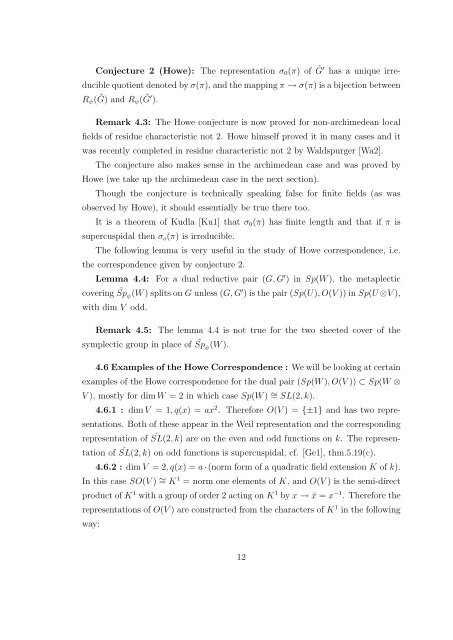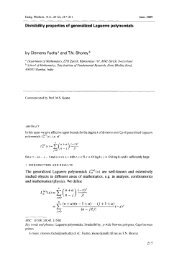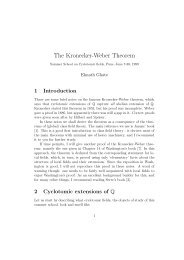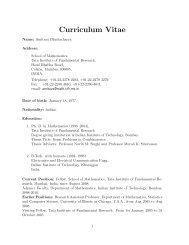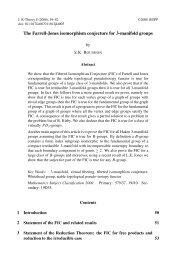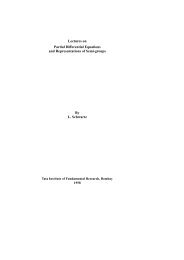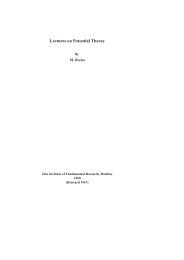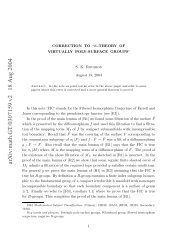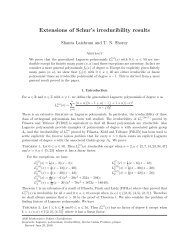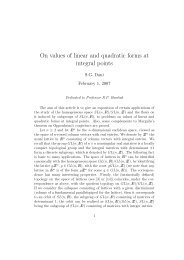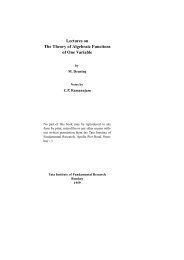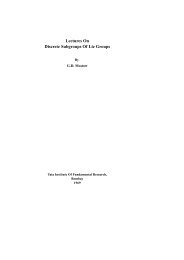Weil Representation, Howe Duality, and the Theta correspondence
Weil Representation, Howe Duality, and the Theta correspondence
Weil Representation, Howe Duality, and the Theta correspondence
Create successful ePaper yourself
Turn your PDF publications into a flip-book with our unique Google optimized e-Paper software.
Conjecture 2 (<strong>Howe</strong>): The representation σ 0 (π) of ˜G′ has a unique irreduciblequotient denoted by σ(π), <strong>and</strong> <strong>the</strong> mapping π → σ(π) is a bijection betweenR ψ ( ˜G) <strong>and</strong> R ψ ( ˜G ′ ).Remark 4.3: The <strong>Howe</strong> conjecture is now proved for non-archimedean localfields of residue characteristic not 2. <strong>Howe</strong> himself proved it in many cases <strong>and</strong> itwas recently completed in residue characteristic not 2 by Waldspurger [Wa2].The conjecture also makes sense in <strong>the</strong> archimedean case <strong>and</strong> was proved by<strong>Howe</strong> (we take up <strong>the</strong> archimedean case in <strong>the</strong> next section).Though <strong>the</strong> conjecture is technically speaking false for finite fields (as wasobserved by <strong>Howe</strong>), it should essentially be true <strong>the</strong>re too.It is a <strong>the</strong>orem of Kudla [Ku1] that σ 0 (π) has finite length <strong>and</strong> that if π issupercuspidal <strong>the</strong>n σ o (π) is irreducible.The following lemma is very useful in <strong>the</strong> study of <strong>Howe</strong> <strong>correspondence</strong>, i.e.<strong>the</strong> <strong>correspondence</strong> given by conjecture 2.Lemma 4.4: For a dual reductive pair (G, G ′ ) in Sp(W ), <strong>the</strong> metaplecticcovering ˜ Sp ψ (W ) splits on G unless (G, G ′ ) is <strong>the</strong> pair (Sp(U), O(V )) in Sp(U ⊗V ),with dim V odd.Remark 4.5: The lemma 4.4 is not true for <strong>the</strong> two sheeted cover of <strong>the</strong>symplectic group in place of Spψ ˜ (W ).4.6 Examples of <strong>the</strong> <strong>Howe</strong> Correspondence : We will be looking at certainexamples of <strong>the</strong> <strong>Howe</strong> <strong>correspondence</strong> for <strong>the</strong> dual pair (Sp(W ), O(V )) ⊂ Sp(W ⊗V ), mostly for dim W = 2 in which case Sp(W ) ∼ = SL(2, k).4.6.1 : dim V = 1, q(x) = ax 2 . Therefore O(V ) = {±1} <strong>and</strong> has two representations.Both of <strong>the</strong>se appear in <strong>the</strong> <strong>Weil</strong> representation <strong>and</strong> <strong>the</strong> correspondingrepresentation of SL(2, ˆ k) are on <strong>the</strong> even <strong>and</strong> odd functions on k. The representationof SL(2, ˆ k) on odd functions is supercuspidal, cf. [Ge1], thm.5.19(c).4.6.2 : dim V = 2, q(x) = a · (norm form of a quadratic field extension K of k).In this case SO(V ) ∼ = K 1 = norm one elements of K, <strong>and</strong> O(V ) is <strong>the</strong> semi-directproduct of K 1 with a group of order 2 acting on K 1 by x → ¯x = x −1 . Therefore <strong>the</strong>representations of O(V ) are constructed from <strong>the</strong> characters of K 1 in <strong>the</strong> followingway:12


